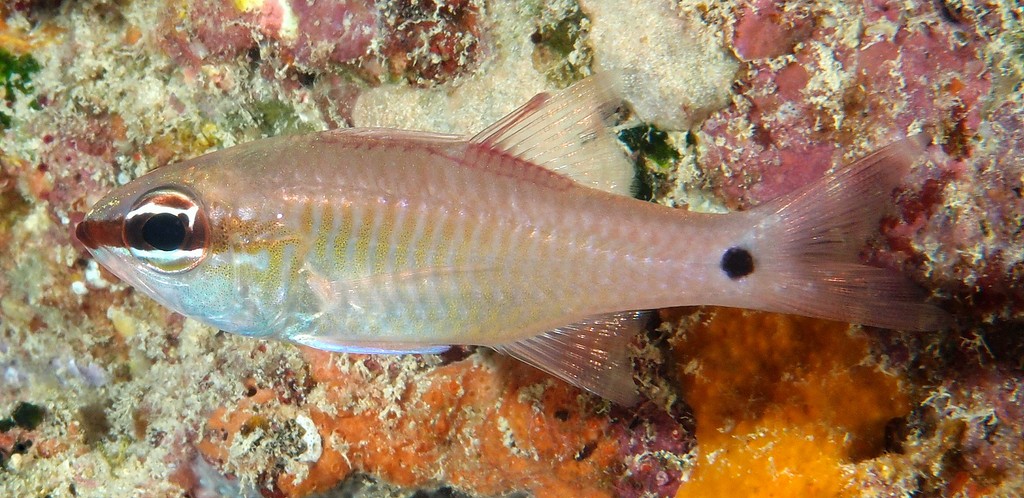OSTORHINCHUS FLAVUS - (ALLEN & RANDALL, 1993)
Actinopterygii (Gigaclass) > Actinopteri (Class) > Teleostei (Subclass) > Gobiiformes (Order) > Apogonoidei (Suborder) > Apogonidae (Family) > Apogoninae (Subfamily) > Ostorhinchus (Genus)
Apogon jaune, Apogon cuivré, Yellow cardinalfish, Brassy cardinalfish, 金黃天竺鯛,
Synonyme
Apogon flavus (Allen & Randall, 1993)
--------------------------
Description
Dorsal spines (total): 8; Dorsal soft rays (total): 8-9 (usually: 8); Anal spines: 2; Anal soft rays: 8-9; Pectoral fin rays: 14-15 (usually: 15); Lateral line scales: 24; Predorsal scales: 4; Gill rakers: 25-27; Body depth: 2.6-2.8 in SL. Preopercular margin fully serrate; Preopercular ridge serrate, mainly on lower portion. Max. length: 9.6 cm SL. Depth range: 10 - 75 m, usually: 25 - 60 m.
Color
Bright yellowish-orange body with a black spot centred on the tail base, a pair of white stripes through eye, and a brown stripe in front of the eye.
Etymology
Ostorhinchus: from Greek, osteon = bone + from Greek, rhynchos = beak. In reference to the bony jaws, very much advanced and jagged, which take the place of the teeth.
flavus: from Latin, flavus = yellow or blond. Referring to the color that covers most of its body.
Orignal description: Apogon flavus Allen & Randall, 1993 - Type locality: west side of Nepean Island, Norfolk Island, about 29°05'S, 167°59'E, depth 15-20 meters.
Distribution
Western Pacific, Southwestern Pacific: Lord Howe Island and Norfolk Island (Australia) and New Caledonia.
Biology
Benthic species which inhabits coral reef. Mouthbrooder. Distinct pairing during courtship and spawning.
Similar species
Ostorhinchus capricornis (Allen & Randall, 1993) - Reported from New Caledonia - Link to the species (here). Has a pair of blue stripes through the eye versus white stripes in Ostorhinchus flavus.
Ostorhinchus cladophilos (Allen & Randall, 2002) - Reported from New Caledonia - Link to the species (here).
Ostorhinchus diversus (Smith & Radcliffe, 1912) - Reported from Western Pacific.
Last update: 28, September 2022
Apogon jaune, Apogon cuivré, Yellow cardinalfish, Brassy cardinalfish, 金黃天竺鯛,
Synonyme
Apogon flavus (Allen & Randall, 1993)
--------------------------
Description
Dorsal spines (total): 8; Dorsal soft rays (total): 8-9 (usually: 8); Anal spines: 2; Anal soft rays: 8-9; Pectoral fin rays: 14-15 (usually: 15); Lateral line scales: 24; Predorsal scales: 4; Gill rakers: 25-27; Body depth: 2.6-2.8 in SL. Preopercular margin fully serrate; Preopercular ridge serrate, mainly on lower portion. Max. length: 9.6 cm SL. Depth range: 10 - 75 m, usually: 25 - 60 m.
Color
Bright yellowish-orange body with a black spot centred on the tail base, a pair of white stripes through eye, and a brown stripe in front of the eye.
Etymology
Ostorhinchus: from Greek, osteon = bone + from Greek, rhynchos = beak. In reference to the bony jaws, very much advanced and jagged, which take the place of the teeth.
flavus: from Latin, flavus = yellow or blond. Referring to the color that covers most of its body.
Orignal description: Apogon flavus Allen & Randall, 1993 - Type locality: west side of Nepean Island, Norfolk Island, about 29°05'S, 167°59'E, depth 15-20 meters.
Distribution
Western Pacific, Southwestern Pacific: Lord Howe Island and Norfolk Island (Australia) and New Caledonia.
Biology
Benthic species which inhabits coral reef. Mouthbrooder. Distinct pairing during courtship and spawning.
Similar species
Ostorhinchus capricornis (Allen & Randall, 1993) - Reported from New Caledonia - Link to the species (here). Has a pair of blue stripes through the eye versus white stripes in Ostorhinchus flavus.
Ostorhinchus cladophilos (Allen & Randall, 2002) - Reported from New Caledonia - Link to the species (here).
Ostorhinchus diversus (Smith & Radcliffe, 1912) - Reported from Western Pacific.
Last update: 28, September 2022
